For a few words about my
reviewing process and preferences, please see the introduction to
Classical Review #36.

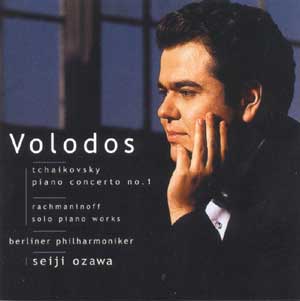 |
TCHAIKOVSKY PIANO CONCERTO NO. 1 •
RACHMANINOFF SOLO PIANO WORKS • ARCADI VOLODOS, PIANO • BERLINER
PHILHARMONIKER, SEIJI OZAWA • SONY CLASSICAL SH 93067 (Hybrid SACD)
|
|
0 |
5 |
|
Performance |
 |
|
Sonics |
 |
|
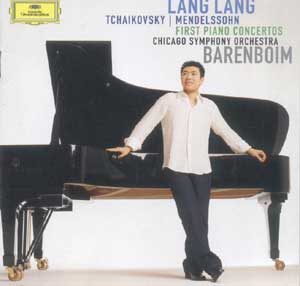 |
TCHAIKOVSKY PIANO CONCERTO NO. 1 •
MENDELSSOHN PIANO CONCERTO NO. 1 • LANG LANG, PIANO • CHICAGO SYMPHONY
ORCHESTRA, DANIEL BARENBOIM • DEUTSCHE GRAMMOPHON B0000666-2 (Also
available as a Hybrid SACD)
|
|
0 |
5 |
|
Performance |
 |
|
Sonics |
 |
|
It is essential to explain how I have arrived at my sonic evaluations of
these recordings. While both were auditioned on the same two-channel
equipment, the Volodos and Kern versions arrived chez Serinus as hybrid
multi-channel SACDs, while the Lang Lang came as a conventional two-channel
CD. Some critics have noted that despite claims that the 16-bit, 44.1 khz
two-channel CD layer of a hybrid SACD sounds identical to the same
performance issued in conventional CD format, it often sound inferior. It
has been postulated that the need of the laser to penetrate two layers of a
hybrid SACD disc may be the cause of this diminution of sound quality. It is
therefore impossible for me to state with absolute certainty that DG has
performed a better recording job than Sony. Before I could speak with
certainty, I would need to compare either the hybrid SACD versions of the
Lang Lang and Volodos or the conventional CD version of both.
Thanks to its unforgettable opening melody, which invariably insinuates its
way into the heart, Tchaikovsky's First Piano Concerto has earned a
deservedly permanent place in the repertoire. Initially sung by the
orchestra punctuated by thunderous chords from the piano, the first theme
undergoes several permutations as it migrates first to the piano and then to
the orchestra, each time with greater effect. But there are so many
additional beauties to the work. These include the two Ukranian folk
melodies that Tchaikovsky incorporated into the score; a most tender middle
movement Andantino, its lyrical opening and closing bookending a jaunty
mid-section; and a vigorous, fiery final Allegro.
Arcadi Volodos' rendition of the concerto is the third to arrive from a
major label in the past few months. As with the other two, the first
featuring Lang Lang backed by the Chicago Symphony Orchestra and Daniel
Barenboim (Universal Classics), the other showcasing 2001's Eleventh Van
Cliburn International Piano Competition winner Olga Kern supported by the
Rochester Philharmonic Orchestra and Christopher Seaman (Harmonia Mundi),
the recording is available as an SACD-hybrid multi-channel disc.
Although Volodos barely approaches the breakneck speed with which Vladimir
Horowitz and his father-in-law Arturo Toscanini whipped the NBC Symphony
Orchestra through the work in 1941 (just re-released on the two disc
Vladimir Horowitz: Legendary RCA Recordings RCA/BMG 82876-56052-2), he and
Ozawa achieve the fastest performance of the three digital versions under
consideration. Theirs is also the most consistently involving. While some
might attribute their success in part to the extra frisson of live
performance, there is a unifying conception to Volodos' approach that leaves
listeners focusing less on technique (dazzling though it may be) than on the
myriad beauties and internal logic of the music itself.
Since sound is frequently manipulated in the recording studio, it would be
foolish to try to state with certainty which pianist makes the opening
chords seems most thunderous. But thunder, of which Volodos supplies plenty
in the finale, is hardly the work's raison d'être. So much of it is filled
with tender lyricism, lyricism of the sort that loses momentum if either
played too slowly or without sufficient attention to the work's singing
line.
Here is where Volodos shines. Every thematic exposition and transition that
Tchaikovsky creates sounds poetic in his hands. Take, for example, the
opening of the middle movement Andantino. An orchestra can play as slowly
and tenderly as it wishes – Barenboim does an exemplary job here – but it is
up to the pianist to make the music sing. And this Volodos does, first with
understated simplicity, then by creating a near magical chiming, shimmering
sound that none of the other pianists achieves. Once through the Andantino's
scampering mid-section, his return to the lyrical melody finds his playing
even more tender than before.
In Volodos' hands, every measure of the concerto seems to lead inevitably to
the next. Where Lang Lang's vision occasionally seems to cloud in slower
passages, as though he's too concerned with details to see farther down the
path; Kern occasionally sounds prosaic; and Horowitz never slows down enough
to smell the flowers, Volodos constantly moves forward, guided by an
understanding that always draws us deeper into Tchaikovsky's universe.
Given that the recording is not Sony's finest – Sony's failure to include
timings is inexcusable -- Volodos' achievement seems all the greater.
Universal brings Lang Lang's instrument more forward, enabling us to hear
every nuance (or lack thereof) that the pianist brings to the work.
Universal's multi-miking also throws into bold relief Barenboim's gorgeously
detailed, near-Wagneresque approach to the score. Ozawa's conducting seems
paradoxically less exceptional yet more in synch with his pianist,
supporting the artist rather than outnuancing him.
Volodos' disc concludes with seven short solo works by Rachmaninoff,
including Volodos' transcription of the Italian Polka. Recorded earlier this
year in a Berlin studio, they nicely capture the piano's full dynamic range.
A comparison of the lovely Prèlude in G Major, Op. 32 No. 5 shows Horowitz
at his famed 1987 Moscow recital even more magical, his playing
distinguished by barely audible, hushed tones and extraordinary shadings.
The Moment Musical in E-flat Minor, Op. 16 No. 2 finds Rachmaninoff himself
in an even more dynamic mode. But taken as a whole, the pieces provide a
satisfying conclusion to this major addition to the Tchaikovsky discography.
Lang Lang does a fine job with the Mendelssohn Piano Concerto (the first
concerto he ever played in public at age 7), but it is for the Tchaikovsky
that most will buy one of these discs. Those who love the music will choose
Volodos.

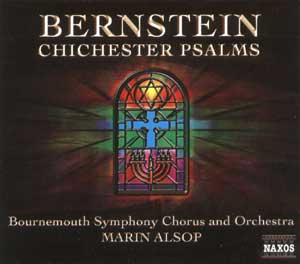 |
BERNSTEIN: CHICHESTER PSALMS •
BOURNEMOUTH SYMPHPONY CHORUS AND ORCHESTRA, MARIN ALSOP • NAXOS
8.559177
|
|
0 |
5 |
|
Performance |
 |
|
Sonics |
 |
|
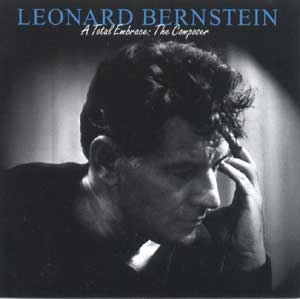 |
LEONARD BERNSTEIN • A TOTAL EMBRACE:
THE COMPOSER • SONY LEGACY S3K 90582 (3 discs)
|
|
0 |
5 |
|
Performance |
 |
|
Sonics |
 |
|
 |
LEONARD BERNSTEIN: A JEWISH LEGACY •
NAXOS 8.559407
|
|
0 |
5 |
|
Performance |
 |
|
Sonics |
 |
|
Few contemporary composers would transform a cathedral commission into an
opportunity to create a pantheistic, subtly subversive statement of
universal brother/sisterhood. But that is exactly what Leonard Bernstein
(1918-1990) did when, in response to a commission for the combined choirs of
England's Winchester, Salisbury and Chichester cathedrals, he set his
Chichester Psalms (1965) in Hebrew rather than Latin. Not only that, but he
entrusted their first performance not to a traditional cathedral all-male
choir, but to a mixed, adult choir accompanied by the New York Philharmonic.
As a new Naxos recording of Chichester Psalms from Marin Alsop and the
Bournemouth Symphony Chorus and Orchestra demonstrates, Bernstein created
one of the most accessible and likeable choral works of the 20th century.
Tonal to the core – he called it “the most B-flat majorish piece I've ever
written” -- its three sections are set to complete and excerpted Old
Testament psalms. The performance is aptly bookmarked by performances of
music from Bernstein's On the Waterfront and On the Town.
The Psalms' opening is classic Bernstein, its “Make a joyful noise unto the
Lord all ye lands” couched in the same jazzy, swinging idiom as West Side
Story. It hardly matters that we're skipping down the streets of New York
rather than immersing ourselves in the pious sanctity of cathedral worship;
the music is that good-natured and appealing. “The Lord is my shepherd” is
couched in gentle lyricism, abruptly interrupted by a jarring “Why do the
nations rage.” After a brief interlude that sounds like a knife striking
into the heart, the work blankets us with the same tenderness as felt in
Lenny's classic “To Make our Garden Grow” and “One Hand, One Heart.” Almost
any Jew will recognize the concluding “Hineh mah tov, Umah naimÖ/Behold how
good, And how pleasant it is/For brethren to dwell/Together in unity” as the
words from Psalm 133 sung at countless Jewish festivities. But here, clothed
in new melody, the Psalm becomes a touching affirmation of the blessing of
universal peace.
Bernstein recorded the work twice, first in 1965 with the New York
Philharmonic, later with the Israel Philharmonic. The debut rendition just
reissued in the three-disc Sony Classical Legacy box Leonard Bernstein • A
Total Embrace: The Composer offers an authentic alternative to Alsop's
performance. Comparison is especially apt because when Alsop was a
conducting fellow at Tanglewood in 1988, she was selected to conduct with
the man she describes as her “hero,” Leonard Bernstein.
Alsop's version, recorded with 192 kHz, 24 bit resolution (suitable for
future DVD-Audio release), offers a clear, convincingly atmospheric
cathedral perspective enhanced by excellent miking. The Bernstein NYP
version's soundstage is wider, the music far more upfront and in your face
due to unrealistic multi-miking. Given that New Yorkers have Bernstein's
sound in their blood, their performance is also brasher and more colorful,
the percussion stronger. In the end, both performances speak truth, with
Alsop's bargain-price version especially distinguished by the wonderful boy
soprano Thomas Kelly.
Again from Naxos' invaluable American Classics series comes Leonard
Bernstein: A Jewish Legacy (Naxos 8.559407). This invaluable issue from the
New York-based Milken Archive of American Jewish Music -- one of 50 releases
currently being issued to celebrate the 350th anniversary of the arrival of
the first Jews to the U.S. -- includes many first recordings.
Among the 14 compositions are Bernstein's first surviving complete work, a
neo-Romantic setting of Psalm 148 for mezzo-soprano and piano written at age
17. The longest work, Halil: Nocturne for Flute, Percussion and Piano was
written to honor Yadin Tannenbaum, a 20-year old Israel flutist who was
killed in his tank in the Sinai during one of Israel's many wars. Several
pieces are excerpts from such well-known Bernstein creations as Arias and
Barcarolles and the ballet Dybbuk. Showing Bernstein at his most personal
and familial are three wedding dances written for Lenny's friends and
collaborators Adolph Green and Phyllis Newman.
The performances and recording quality are equally stellar. The soprano who
sings both Psalm 148 and the 1951 song “Silhouette” (Galilee), written to
honor the birthday of Berntein's friend and frequent collaborator,
mezzo-soprano Jennie Tourel, is Angelina Rèaux. Known for her performances
of Weill's The Seven Deadly Sins, Rèaux recorded La Bohëme with Bernstein
and recently created, directed and performed in a Chicago Opera Theater
celebration of his life and work. Other performers of international renown
include tenor Hans Peter Blochwitz, organist Christopher Bowers-Broadbent,
and the BBC Singers. For a side of Bernstein that also surfaced in such
works as the early Jeremiah symphony and Symphony No. 3 (Kaddish), this disc
cannot be beat.

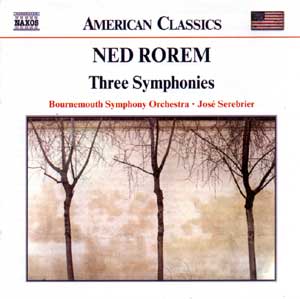 |
NED ROREM: THREE SYMPHONIES •
BOURNEMOUTH SYMPHONY ORHCESTRA, JOS… SEREBRIER COND. • NAXOS 8.559149
|
|
0 |
5 |
|
Performance |
 |
|
Sonics |
 |
|
He has written fifteen books, a good 300 art songs, and dozens of
orchestral, chamber and choral works. Four years ago he was elected
President of the elite American Academy of Arts and Letters. Yet despite
winning the 1976 Pulitzer Prize for his orchestral piece Air Music, earning
renown as America's undisputable master of the vocal idiom, and enjoying the
luxury of spending the last 40 years of his life only writing music on
commission, New York/Nantucket-based composer Ned Rorem has until now seen
his early symphonies largely ignored.
All that is changing. As he approaches the October 23 celebration of his
80th birthday, Rorem can rejoice that his first three symphonies are finally
available on a bargain price disc. They have also just been nominated for a
Grammy, with the award ceremony scheduled for February 8. Since Grammy
nominations are determined by experts in the field, as opposed to the
general membership, the nominations are ultimately more significant than the
awards themselves.
In a recent phone conversation, Rorem pointed out that he has actually
written four symphonies. While the second and fourth were commissioned
works, the other two were composed “for the hell of it.”
As one might expect, Rorem wishes that his early symphonies had received
good recordings forty years ago. Nonetheless, he is pleased by the “very
positive” reviews that have greeted his work. He also rightly praises the
recording itself, which if not of demonstration quality, nonetheless
delivers a wonderfully atmospheric presentation of his music.
Though his three early symphonies more or less disappeared from view within
a few years of their premiere – the Third Symphony fared best --Rorem's
Fourth Symphony, usually identified as String Symphony, received a happier
reception. It was first performed by the Atlanta Symphony under Robert Shaw;
their 1989 recording of the work (New World Records) won a Grammy Award for
Best Orchestral Recording.
Although he has written program notes for many of his works, the sometimes
contradictory, perpetually depressed Rorem remains reluctant to discuss his
compositions. “I don't like to talk about my own music; I don't even like to
read other composers talking about their music, because I think the music
states it better. God knows I never discuss my music aesthetically, because
whatever there is to say about it is stated by the music itself.”
Nonetheless commenting in the liner notes, Rorem writes that The First
Symphony “could easily be called a suite,” Composed between 1948 and 1950,
it received only a few performances before fading into relative obscurity.
While there is no question that Rorem's unabashed tonality grew increasingly
out of favor during the reign of serial supremacy, Serebrier's performance
renders continued cold shoulder treatment incomprehensible. Especially
attractive is the final movement. With one of its themes taken from an Arab
wedding tune Rorem heard on the radio while in Morocco, the music grows
increasingly joyful and animated, with a finish that must have left the
heady intellectuals of earlier decades desperate for multi-syllabic
dismissals.
The Second Symphony, a 1956 commission by Nikolai Sokoloff, received the
last of its few performances in 1959. Hopefully that will change. The
pastoral quality of its lovely second movement unquestionably reflects
Rorem's excellence as a songwriter; the writing is as irresistible as the
rollicking allegro that concludes the work.
Rorem's Third Symphony, composed in 1958, got off to a happy start. “When I
showed it to Bernstein,” Rorem told me, “he decided to program it.” After a
successful New York Philharmonic premiere in Carnegie Hall, performances
were sporadic, perhaps the most recent being by Andre Previn and the Curtis
Institute of Music Orchestra in Carnegie Hall in 2000. The work has also
received two prior recordings, one by Maurice Abravanel and the Utah
Symphony (released on CD in a 2001 VOX box of American Orchestral Music (CDX
5092), the other of the Bernstein premiere recently made available in a
large boxed collection of New York Philharmonic broadcasts of American
music.
Symphony No. 3 is a wonderfully rewarding work, one that deserves wide
performance. Beginning with a big, mysterious opening Passacaglia, it
transitions into a very attractive, jazzy second movement Allegro that was
originally intended for two pianos. The Largo, Rorem's favorite movement of
the symphony, is dreamy and somnambulistic. The fourth movement Andante,
intended as a farewell to France, impresses with colors reminiscent of
impressionist paintings of the French countryside at twilight. Wistful and
lovely, its beautiful atmosphere lingers long in the memory. The same holds
true for the final Allegro molto. With its castanets and snare drum, its
bubbling woodwinds and dance-like lyricism, the movement grows to an
affirming, joyous conclusion that will leave many listeners hitting
“Repeat.”

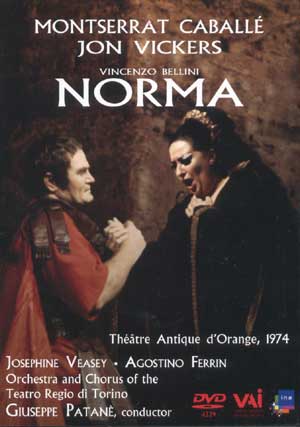 |
BELLINI: NORMA • MONTSERRAT CABALLé,
JON VICKERS • THEATRE ANTIQUE D/ORANGE, 1974 • VAI DVD-VIDEO 4229
|
|
0 |
5 |
|
Performance |
 |
|
Sonics |
 |
|
As I assess my favorite vocal issues of the past year, this fabled
performance goes to the top of the list. For anyone who either loves opera
or wishes to find out what it's all about, this DVD is a must.
1974 was a peak year for Montserrat Caballé. Captured in stunning voice as
Norma, the soprano is in absolute command from her first note to final
utterance. If anything, her performance becomes more detailed and
exquisitely accented as the opera proceeds. Given the circumstances -- a
live outdoor performance in what appears to be an ancient amphitheater
during which the wind seems to have been blowing in the soprano's face at 20
mph -- her control is extraordinary.
For starters, Caballé's “Casta Diva” is exquisite. The diva's unequalled
breath control enables her to deliver one mesmerizing phrase after another.
Alternating between forte phrases devoid of bluster and breathtaking
shimmering pianissimos, she fills the aria with nuance. Those fabled
pianissimos never seem capricious; all make dramatic as well as musical
sense. And when the diva holds onto her final highs for what seems like
forever, spinning them out in a manner designed to drive devotees to
distraction, home viewers will variously gasp, scream, and shake their heads
with disbelief. (You can spy the slight smile of satisfaction that crosses
Caballé's face as the audience goes berserk). With acting remarkably
graceful and convincing, this is a once-in-a-lifetime performance.
Mezzo-soprano Josephine Veasey is nearly Caballé's match as Adalgisa. Her
slimmer figure and golden locks provide visual contrast to Caballé's full
figure, and her voice is in peak form. Whether she sang as well as this on
other occasions, I do not know. But here, no doubt inspired by Caballé's
mastery, she is excellent. With voices and acting blessedly complementary,
the women's “Miro, o Norma” is one to set alongside performances by Caballé/Verrett
and Sutherland/Horne.
I personally think Jon Vickers sounds like a cross between a used car
salesman and a bully, but those who appreciate his energy will enjoy his
portrayal of the despicable Roman consul. (If the pagan Norma is a
barbarian, then George Bush must be the Second Coming). I also suppose that
Vickers' macho blustering is more dramatically appropriate than a
sweeter-voiced tenor in the role. Giuseppe Patanë provides perfect support,
and the chorus is quite fine. The sound is mono, but sufficiently doctored
to satisfy. The photography may not be high definition, but the camerawork
itself is excellent. There are some good shots alongside and behind the
singers, and the site of Caballé's cape blowing in the wind, creating a
silvery halo around her, is a diva's dream.

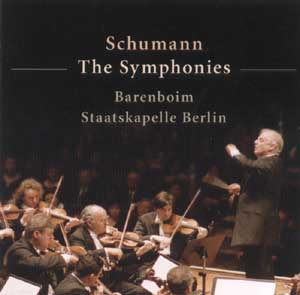 |
SCHUMANN: THE SYMPHONIES •
BARENBOWIM, STAATSKAPELLE BERLIN •
TELDEC 2564 61179-2
|
|
0 |
5 |
|
Performance |
 |
|
Sonics |
 |
|
Berlin's oldest orchestra, the Staatskapelle Berlin embarks on its second
U.S. tour in 433 years in January 2004. The programs come on the heels of
Teldec Classics' January 6 release of the Staatskapelle Berlin's two-disc
set of Robert Schumann's four symphonies.
Some who have heard the orchestra claim that the fact that it remained
sequestered behind the Berlin Wall from 1961 to 1989 enabled it to maintain
the prewar Central European musical tradition. Given that its Jewish
conductor would have been less than welcome during extended periods of
German history, the description can only refer to what a Chicago Tribune
critic called its “warm, dark glow and plush tone so typical of Central
European orchestras from the late 19th century.”
To the extent that this is true, the Staatskapelle partially owes its sound
to its status as one of the few orchestras equally dedicated to the concert
and opera genre. For part of the year, the ensemble serves as the resident
orchestra of the Staatsoper Unter den Linder, giving over 200 opera and
ballet performances a year, as well as many symphonic concerts and over 20
chamber music concerts. Its sound may also stem from its personnel's
conscious and unconscious efforts to tune their playing to the unique
acoustics of their home environment.
Given that the new CDs were recorded in studio, it is difficult to draw
reliable conclusions about the orchestra's sound. Yes, the violins of other
orchestras may sound brighter and have more zing, but that could be a result
of engineering choices. What does remains incontrovertible, besides the
sheer beauty of sound and surety of musicianship heard from the ensemble, is
the extent to which Barenboim draws his players into Schumann's symphonic
universe.
My evaluation focuses on two of the symphonies. The Symphony No. 2 in C
major was sketched in December 1845 while Schumann was recovering from a
nervous breakdown. He constantly complained of “singing” in his inner ear
while undertaking the orchestration, describing the first movement as “full
of struggleÖ capricious and obstinate.” It was only as he worked on the
final movement that he started to feel better.
Schumann's mental state can be sensed in the restless forward momentum of
the opening allegro, the fierce ending of the second movement scherzo, the
uneasy but touching Adagio, and the triumphant concluding Allegro. Not the
most immediately likable of Schumann's symphonies, it does not seem to
elicit Barenboim's deepest symphonies. When his Berlin performance is
compared to the classic 1958 early stereo recording by George Szell and the
Cleveland Orchestra, we hear a more stately opening, = a more extended and
affecting third movement Adagio espressivo, and a more energized conclusion.
Szell, it should be noted, had championed Schumann's symphonies for 29 years
before beginning to record the works, and featured at least one of the
symphonies in 19 of his 24 years as music director of the Cleveland
Orchestra. He was also known to alter the score, clarifying textures, adding
or changing notes to clarify themes, and doing whatever he felt necessary to
bring out the best in works that have often been disparaged by unsympathetic
critics.
Barenboim delivers an exhilarating, irresistible performance of Symphony No.
3 in E-flat Major, “Rhenish.” The last symphony Schumann wrote, this joyous
celebration of German's Rhineland begins exultant. The second movement,
growing in intensity, is lovely, the middle song-like movement gratifyingly
lyrical. The famed fourth movement, inspired by a visit to Cologne
cathedral, is to be performed “in the style of an accompaniment to a solemn
ceremony.” Szell may tap into a deeper mysticism, but Barenboim's solemn
majesty captures German religiosity to a T. The thrilling finale should
leave you cheering in your seat.
- Jason Victor Serinus
-